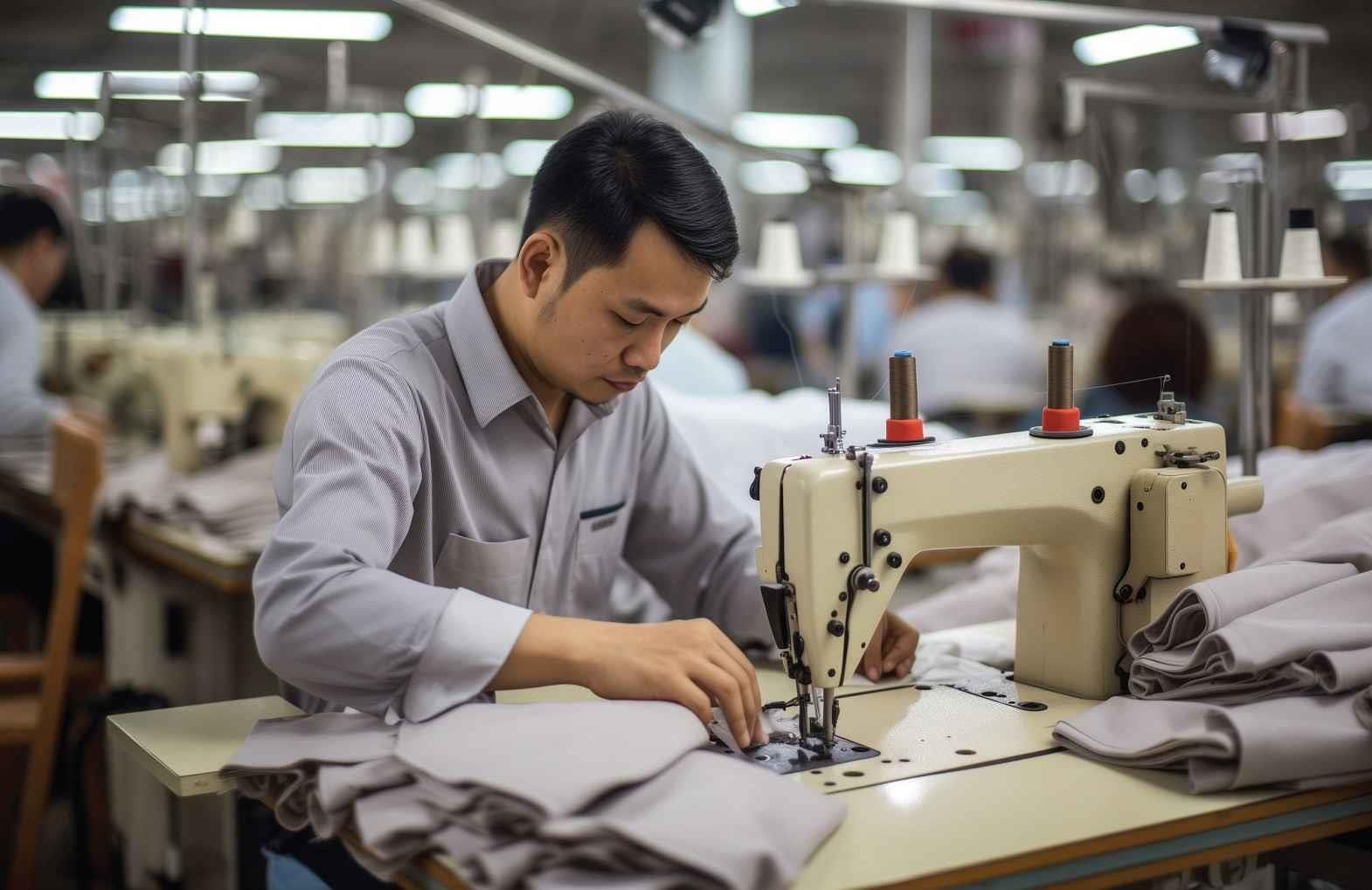In this complex industry, manufacturers source materials, assemble garments, and sell their products to retailers. These high-quality clothes are then distributed to consumers worldwide. Consumers and retailers alike deliberately avoid garments that fail to meet quality standards, as a product with noticeable defects or poor quality is unlikely to find buyers. Consequently, discerning customers often employ rigorous quality inspection systems to avoid purchasing faulty items.
Thus, not meeting quality standards can turn out to be costly, both financially and environmentally. Fortunately, regulatory quality certification programmes, such as the ISO 9000 series, can help businesses maintain quality standards in the apparel sector. This article explores the critical guidelines and practices for quality control in the garment industry.
For the apparel sector, factors like factory operations, the complexity of the supply chain, and adherence to best quality control practices are crucial in determining quality. In countries like China, there is a significant production of fast-fashion items that are intended for only a single season’s use before disposal. In this scenario, it is essential to identify materials and fabrics that are not only fashionable but also of high quality and sustainable.
Understanding Fabric Quality: Three Key Aspects
When evaluating fabric quality, it is crucial to consider three fundamental aspects that significantly impact its performance and suitability for various applications:
Comfort Properties: The comfort of a fabric is influenced by several properties, including its elasticity and elongation, heat conduction and retention, moisture absorbency, water repellency, and waterproofing. Additionally, the way a fabric feels against the skin, its drape, and air permeability are vital factors that contribute to its overall comfort.
Colourfastness: This refers to a fabric’s ability to maintain its appearance over time. To assess colourfastness, the fabric undergoes testing under various conditions, including exposure to different environments, friction (crocking), and reactions to acids and alkalis. This testing ensures that the fabric can retain its colour and appearance through wear and environmental exposure.
Durability: Durability is gauged by how different materials used in a fabric withstand varied conditions. This includes testing the strength of both warp and weft threads of the cloth until they break. The aim is to understand how long the fabric can maintain its integrity and performance under stress or during regular use.
Key Functions of Quality Control Department
A quality control department plays a vital role in ensuring the standard and consistency of products or services. The most common functions of this department include:
1. Quality Control Checks for Internal and Outsourced Processes
Quality control departments conduct several critical checks to ensure the integrity and standard of both internal processes and outsourced work. These checks include:
Inspection of Raw Material: This involves the thorough inspection of raw materials to ensure there are no defective or damaged items.
Testing of Raw Materials: Instead of direct testing, the quality control department sends samples to an external testing facility. These samples are examined for their chemical and physical properties. Based on the test reports received, the quality control team decides which raw materials to approve for use.
Sample Inspection: This includes a visual examination and measurement verification of samples before they are sent to buyers.
Cutting Room Inspection: The quality department also inspects the operations in the cutting room. This involves checking tasks such as fabric layering on cutting tables, inspecting cut components and layers, and examining fabric bundles.
Preparatory Work Inspection: High-end garments often require preliminary tasks like printing, beading, and various forms of embroidery, which are frequently outsourced. The quality department inspects these outsourced components before they are sent to the cutting section or the sewing lines.
Sewing Process Inspection: Various inspection methods are used on the sewing floor, including audits of stitching quality, end-of-line inspections, and inline inspections.
Finishing Process Inspection: Finally, the quality staff conducts audits and inspections of the packaged and finished goods before they are handed over to external inspectors for final shipment approval.
2. Quality Control System Development
The quality control department must formulate a strategy detailing the specifics of inspection, including what needs checking, the extent of these checks, and the quality standards for each process.
Developing a comprehensive quality management system is crucial for ensuring high-quality production in garment manufacturing. This system, overseen by the quality control department, includes:
-
Establishing quality checking procedures.
-
Creating examples of defective and correct work for reference.
-
Training quality inspectors and checkers, either in-house or through external workshops.
-
Developing quality manuals to guide operations.
3. Auditing Output of Each Process
Besides inspecting garments, raw materials, and cutting panels, the quality team audits completed work. While all work undergoes quality assurance, typically only about 5-10 per cent is subject to detailed auditing.
The Acceptable Quality Limit (AQL) sampling method is employed to determine the number of garments to be audited from the ready lot.
4. Quality Awareness Development Among Employees
A key role of the quality control department is to foster a culture of quality awareness. This includes:
-
Displaying banners emphasising the importance of getting things right the first time.
-
Educating employees about the costs associated with poor quality and delays caused by quality issues.
5. Preparing Quality Reports
Quality auditors and checkers are tasked with producing regular reports for all checkpoints and auditing procedures.
These reports are summarised and analysed using process and quality key performance indicators (KPIs), including:
-
Assessment of fabric quality based on penalty points, deciding acceptance or rejection of fabric lots.
-
Calculation of the rate of damaged panels in cutting.
-
Calculation and reporting of Defective Handling Units (DHU) and defect percentage in each production line during sewing.
-
In the finishing process, preparing reports on defective percentage and DHU, and reporting damaged garments.
-
Identifying major and frequently occurring defects.
-
Generating Quality KPIs on a daily or weekly basis.
-
Some companies also prepare cost of quality reports.
6. Coordinating Product Quality Issues with Buyers and Merchandisers
Understanding the quality requirements for new styles is essential for the quality control team.
This involves:
-
Meeting with buyers’ representatives or factory merchandisers to discuss quality standards, garment specifications, and tech packs.
-
Obtaining approval from buyers and merchandisers on trims and manufacturing quality.
-
Providing quality reports for each order to the buyers.
-
Creating quality checking reports during sample submissions.
Role of Quality Control in Different Production Steps
The primary role that Quality Control (QC) plays in production steps is as follows:
Determining Product Quality: Before production begins, the desired quality level of the final product is established, usually specified by the client. It is the supervisor’s responsibility to ensure that the final product aligns with these requirements.
Quality Checks on Raw Materials: Quality inspection of raw materials, especially fabric, is essential before starting production. Checks include evaluating colour, thickness, colourfastness, GSM (grams per square metre), and identifying any defects.
Quality Inspections in Cutting and Placing Fabric: At this stage, precision is crucial. Mistakes in cutting or placing fabric can lead to significant losses. Ensuring accurate marking, proper alignment with machines, precise drill hole positioning, and avoiding yarn fraying at corners are essential. Only trained personnel should handle cutting machinery to minimise errors.
Quality Checks During Sewing: The overseer ensures that the correct pieces are sewn together properly. Attention is paid to thread colour, garment measurements, and needle size. Errors at this stage are relatively easier to rectify.
Quality Checks on Embellishments: Attention to detail is vital when inspecting embellishments. This includes ensuring smooth zipper operation, proper hook and eye fastenings, and alignment of buttons and buttonholes.
Final Checking: After stitching and adding embellishments, a final quality check is conducted to ensure the garment meets client specifications. Key considerations include:
-
The overall appearance of the stitched item.
-
The garment’s colour, cut, and stitching quality.
-
The drape and feel of the garment.
-
The size and shape of the garment.
-
The colourfastness.
Once these aspects are verified and deemed to meet the initial standards, the quality check is deemed complete. Any defective items are separated, and the rest are prepared for packaging.
Importance of Quality Control
Quality Control (QC) plays a crucial role in garment manufacturing, offering numerous benefits:
Customer Satisfaction: QC ensures garments meet or exceed customer expectations, minimising the risk of producing substandard products. This leads to enhanced customer experiences, fostering loyalty and a positive brand image.
Consistency in Product Standards: It standardises production to meet specific specifications, ensuring uniform quality across all garments and aiding in inventory management and demand forecasting.
Economic Implications: QC drives sales by attracting and retaining customers with high-quality garments. It also reduces long-term production costs by minimising defects, rework, and waste, and helps avoid financial losses from recalls and returns.
Operational Efficiency: Identifying and addressing quality issues early improves overall efficiency, reduces costly rework, optimises resource use, and minimises disruptions in production workflows.
Regulatory Compliance: QC ensures compliance with safety and quality standards set by regulatory bodies, avoiding legal consequences and demonstrating commitment to consumer protection.
Brand Image and Reputation: Consistently high-quality products build a positive brand image, fostering trust and reliability among consumers and encouraging brand loyalty.
Cost Savings: QC minimises production costs by preventing defects and rejections, reducing the need for extensive QC efforts post-production and contributing to long-term profitability.
Risk Mitigation: It identifies potential quality issues early, reducing the risk of widespread defects and minimising the likelihood of financially and reputationally damaging product recalls.
Supply Chain Management: QC improves supply chain reliability by setting and monitoring quality standards and ensuring consistent quality across all components.
Continuous Improvement: QC fosters a culture of ongoing improvement, encouraging feedback and learning from past mistakes to enhance future production, and supporting innovation and new technology adoption.
Global Competitiveness: By meeting or exceeding international quality standards, QC positions companies as competitive players in the global market, enhancing the industry’s reputation worldwide.
Conclusion: The Vital Role of QC in the Apparel Sector
Quality control is indispensable in the apparel industry to ensure that all garments adhere to specific standards, requirements, and regulations. Its role in maintaining consistency and quality cannot be overstated. However, overseeing QC can be challenging, especially when the actual manufacturing facilities are located thousands of miles away from the buyer. This geographical distance often complicates the direct supervision of production quality. In such scenarios, the employment of independent quality inspectors becomes invaluable. These inspectors bridge the gap, providing an essential service to ensure that garments meet the required standards before shipment, thereby safeguarding the interests of both manufacturers and buyers.








Comments